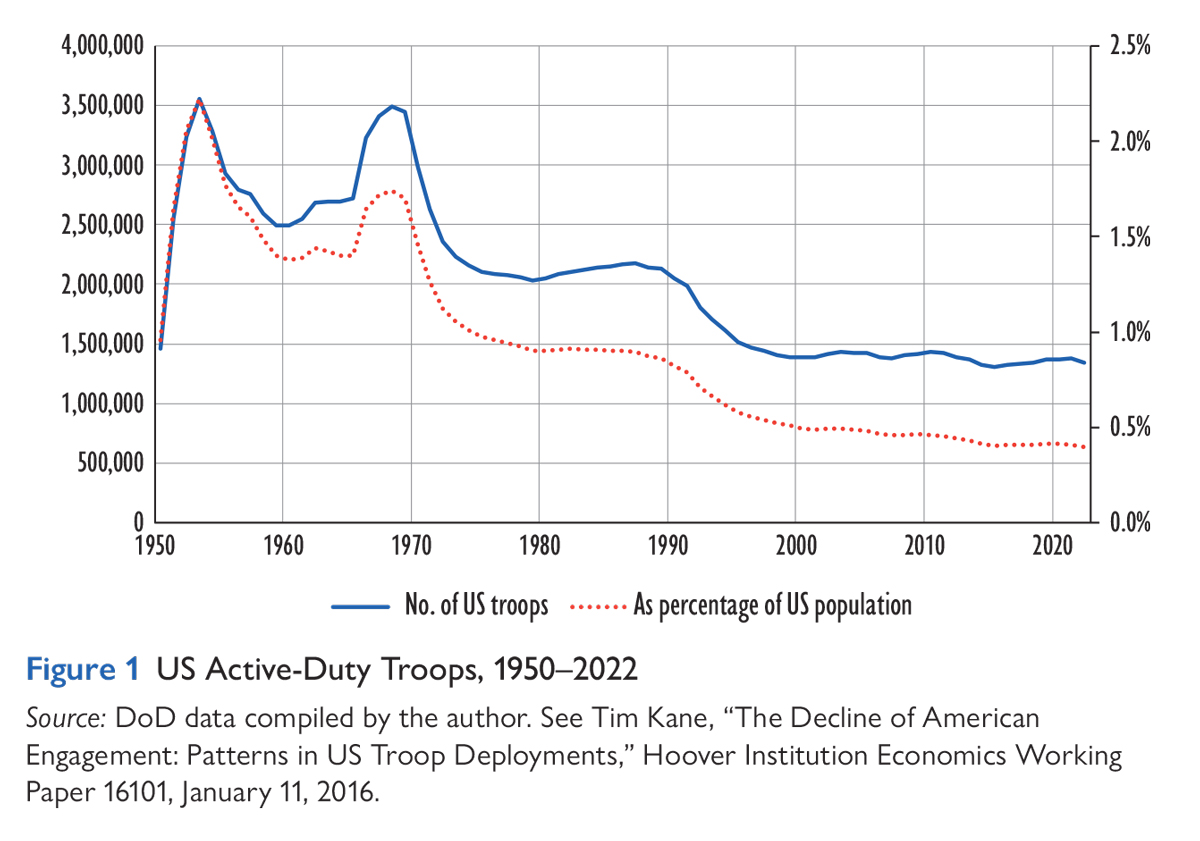
- Determining America's Role in the World
This essay is adapted from Defense Budgeting for a Safer World: The Experts Speak, a new publication by the Hoover Institution Press.
American military manpower is remarkably successful as we mark the fiftieth anniversary of the all-volunteer force (AVF). American troops have been notably productive in waging warfare and securing peace. The results on both fronts are impressive even as personnel costs continue to grow. Although the motivation to end conscription in 1973—properly understood as coerced labor by Milton Friedman, Martin Anderson, and other economists who were affiliated with the Hoover Institution—was driven more by social and political considerations of justice than by budgets or strategy, the timing was fortuitous for the advent of the technological revolution in military affairs. An insightful comment on the relentless technological arms race comes from Ukrainian Vice Prime Minister Mykhailo Fedorov’s recent remark in an Atlantic article: “In the last two weeks, we have been convinced once again the wars of the future will be about maximum drones and minimal humans.” An overstatement, to be sure, but today even infantry soldiers are required to handle sophisticated technology, forcing Pentagon leaders to optimize military talent in what promises to be a new era of budget deficits and budget constraints.
My research explores the cost of military personnel and challenges us to rethink policy and strategy in light of a broader perspective that considers benefits. I focus on the active force, not the millions of Americans serving in the National Guard and reserves, nor Department of Defense (DoD) civilians and military contractors, although they are shaped by similar regulations.
Marines, airmen, sailors, and soldiers are not interchangeable parts with fixed costs and identical utility; rather, each is a uniquely talented individual. Quality matters. Utilization matters, too. The readiness goal for any talent management system should be to optimize talent quality. That principle seems obvious but is surprisingly at odds with much of the design of personnel policies in large organizations everywhere. Large organizations routinely build their personnel operations, as the saying goes, to fight the last war. That seems doubly true for the Pentagon, which still uses pay tables and an “up-or-out mentality” that were cutting edge during the days of General Dwight Eisenhower in the 1940s.
Smaller but more lethal
As of October 31, 2022, 1.3 million Americans were serving on active duty in the five branches of the US military. That compares to 3.5 million service members in the early 1950s and late 1960s, or roughly one-third of the troop strength at the peak of the Cold War (see figure 1). When considered as a percentage of the US population over time, the military is currently one-sixth of that size, having decreased from 2.2 percent of the national population during the Korean War to 0.4 percent now. Yet many would argue that the force is more lethal now than ever before. This partly explains why even though the headcount has declined by more than half since the 1950s, the total budgetary cost of personnel in inflation-adjusted dollars has more than doubled.

Recruiting for all military branches in FY2022 was difficult; it was arguably the worst year since 1973 and only the fourth that the military had missed its recruiting goals. The Army fell short by fifteen thousand recruits in 2022—25 percent of its annual goal—then subsequently cut its projection for the overall force size by ten thousand soldiers. These difficulties are similar to those of past cycles, with a strong correlation to the civilian unemployment rate. The AVF competes against employers in the private sector, so recruiting is always more challenging when the labor market is tight.
Although the FY2022 recruiting shortfall was heavily covered in the mainstream press, a unique factor is that it happened during the first year of peace after two full decades of US fighting in the Middle East—specifically, large and lengthy troop deployments to Iraq and Afghanistan. The increased interest in military service, and the increased quality of recruits, after the 9/11 attacks is a remarkable and underreported phenomenon.
The DoD maintains high quality standards for enlistees. Before framing this as a problem, consider the benefits. In terms of literacy, raw intelligence, strength, physical resilience, and more, young enlistees in the American military do not “look like America” because they are measurably better. In terms of racial and religious demographics, both enlistees and officers are a healthy reflection of the national population, even as the goal remains to have a military workforce that is not just average but measurably as smart, strong, and honorable as possible. High standards mean that 70 percent of the thirty-three million Americans between the ages of seventeen and twenty-four cannot meet the minimum enlistment standards, implying a pool of 9.9 million potential recruits. Yet according to Stefan Borg, writing in Parameters, only 136,000 of that pool express a willingness to serve—a mere 1.5 percent of the eligible pool.
What goes into military pay?
Personnel costs account for one of every five defense dollars—even more when accounting for deferred costs associated with veterans’ health care. According to the Congressional Budget Office (CBO), military pay represents 55 percent of total compensation for the average officer and 53 percent for the average enlisted service member. I use the definition of “pay” as regular military compensation that includes base/basic pay, allowances for housing and food, and the tax advantage of various allowances. Health care for the active force represents another 9 percent to 14 percent of costs. The remainder is deferred costs, with Veterans Affairs (VA) benefits, retiree health care, and retirement pensions.
In contrast, basic pay is disbursed using a rigid formula based on two factors: the number of years in service and rank. However, an individual’s rank is based almost entirely on years in service (following rigid promotion timetables). The net effect is that 99 percent of military pay is based on seniority and less than 1 percent on skill, merit, or performance. Special pays exist for hazardous duty and some sixty other categories, though none is based on performance. This stands in sharp contrast to billions of dollars allocated to bonuses for retention each year, which are universal rather than individually targeted. Paying for performance remains a major area for improvement, given that the law allows great leeway in the use of assignment-incentive pay and other channels to compensate talent directly. One option would involve legislators decoupling military pay raises from the basic pay tables or going further by requiring the services to disburse pay raises as bonuses for merit, performance, and (applied) skills.
The pay premium masks problems
In 2002, the Ninth Quadrennial Review of Military Compensation (QRMC) concluded, “Pay at around the 70th percentile of comparably educated civilians has been necessary to enable the military to recruit and retain the quantity and quality of personnel it requires.” What does it mean that pay was around the 70th percentile? Higher-than-average pay represents a premium, which labor economists explain as compensation for harder, hazardous work. A similar premium is paid to comparably educated workforces in law enforcement and deep-sea fishing, as just two examples. Other explanatory factors for the military pay premium include the higher levels of health and fitness demanded of uniformed service members. This military pay premium weighs heavily on the Pentagon budget, especially if it increases. At the time of the 2012 QRMC report, pay had risen to the 90th percentile (education controlled) for enlisted members and the 83rd percentile for officers. The most recent QRMC, published in 2020, found that the high premium had continued: “For the first twenty years of service, [pay] was at the 85th percentile of the civilian wage distribution for enlisted personnel and at the 77th percentile for officers.”
The pay premium for military labor could be reduced if the quality of life of service members were better. Surveys routinely find that troops do not value many military fringe benefits, whereas they report frustration with rigid personnel policies such as frequent job rotations (especially the impact of cross-state moves on spouses and children). The unit budgetary cost for labor, which has risen in recent decades, could be alleviated by personnel reforms such as fewer permanent-change-of-station (PCS) moves and more personal control over careers (including more fluidity to exit and re-enter the ranks).
From citizen to professional
While the all-volunteer force deserves praise and celebration on its fiftieth anniversary, it must be remembered that the transition from a citizen army to a professional army was instituted by letting the clock run out on the draft law, not by design. A dozen reforms, large and small, were recommended by the Gates Commission in 1970, but none was implemented other than ending the draft, meaning that the transition to a fully volunteer force remains incomplete.
The budgetary costs of failing to implement some of the commission’s reforms (e.g., widespread lateral entry) are negligible, but the economic costs can be high. As the late Hoover fellow George Shultz noted, “The ironic thing about the all-volunteer force is that those who enter the armed services volunteer only once—when they join. After joining the armed forces, their careers become subject to a variety of regulations, regardless of their own preferences.” In a nutshell, the DoD’s current system spends millions training individuals to reach peak productivity at twenty years in uniform, then an additional $1 million (net present value retirement pension) incentivizing them to leave immediately. Recent secretaries of defense have expressed frustration with the “bureaucratic concrete” in the personnel system as one of the greatest challenges the military must overcome to win wars of the future.
Recall that talent management aims to increase the numerator of talent over the denominator of expense, i.e., to maximize productivity. In that light, policies that lead to a marginal reduction of talent—bleeding talent through external loss or internal misallocation—reduce the numerator and, therefore, net productivity. We can call this “less lethality for the buck.”
One key policy to enhance the numerator—lateral entry—has been authorized as of the 2017 NDAA but remains very sparsely implemented. Choice of occupation has been more widely applied among the services in the past five years, with the creation of job-assignment marketplaces online that hold tremendous promise (more career control is the top desire for service members who consider leaving the ranks). Yet a serious impediment to all this is the rigid retirement structure. Consider the puzzle of trying to attract a world-class cyber expert with ten years of civilian experience to an assignment as a US Air Force major—how does her military retirement work? It doesn’t. Or how does the retirement system handle a sailor who leaves for multiple opportunities, gains invaluable logistics expertise, and then wants to re-enlist?
The Pentagon’s defined benefit (DB) pension, with its 100 percent vesting after twenty full years, is coercive to such an extreme that it would be illegal in the private sector. Federal law governing all public and private pensions mandates that DB pensions partially vest one-fifth of the funds after three years or less; all funds at seven years or less. The US military pension is not worthy of a professional force. As the Gates Commission noted in 1970, all-or-nothing vesting at twenty years has “a number of undesirable effects,” one being that it has little to no value in recruiting. The commission noted two other perverse incentives, the first being that soldiers “cannot afford to separate from the service” beyond their tenth year, and second, that it “induces many individuals to retire as soon as they are eligible.” Payments from the pension begin immediately upon retirement, instead of at some fixed age.
In short, too many personnel stay in uniform before the twenty-year cliff, and too few stay after.
Consider the prospect of any other organization losing half of its employees with twenty years of experience—age thirty-eight for noncommissioned officers, age forty-two for officers—every year, and how daunting that would be. Unless the perverse incentives of the pension’s cliff vesting at twenty years are reformed, it will be difficult to manage talent.
A force multiplier
Today, with fewer than seventy thousand boots on European ground, American engagement is close to one-fifth of its Cold War presence. Did this drawdown yield a peace dividend that helped lower national deficits and allow greater investments in new weapons systems? That’s hard to see. Even so, it was sold as such, and too often the defense-budget conversation frames personnel as a trade-off for modernization, as per a recent Congressional Research Service report: “Some have raised concerns about the impact of personnel costs on the overall defense budget, arguing that they decrease the amount of funds available for modernizing equipment and sustaining readiness.” This might be a false choice. Today, there are fewer deployed US troops based overseas relative to the world population than at any time since 1950. Yet annual US budget deficits have risen so high that the baseline deficit now exceeds $1 trillion (or 5 percent of GDP). History will think of the “peace” dividend not so much as a cost saving after a drawdown, but rather as the fruits of prosperity as a consequence of deterrence earned by higher troop numbers. That’s the real American security umbrella.
The cumulative cost of all US bases abroad is an estimated $55 billion, roughly the same as the $50 billion in aid sent to Ukraine by the United States in the year after Russia invaded. An ounce of prevention would have been worth a pound of war.
The all-volunteer force remains a vibrant multiplier of American hard and soft power fifty years after its start. While there is ample room for improved productivity and reform, it should be remembered that near-peer rivals in China and Russia depend on conscripted armies, with all of their myriad dysfunctions that the Pentagon left behind a half century ago. Pushing for more advanced drones, cyber, intelligence, and other modernizations in capital equipment is vital, but defense leaders should never forget that maintaining the talent edge requires constant innovation as well.

















